We continue working with the U.S. Bureau of Land Management and Colorado Parks and Wildlife on creating 2 wildlife kiosks to be put along the I-70 corridor west of Grand Junction. Installation date should be sometime in spring of 2024. To see previews of 3 of the posters from the Prairie Dog Kiosk, go to our prairie dogs page. Here are the three posters for our Riparian Wildlife Kiosk:
First one is the left poster:
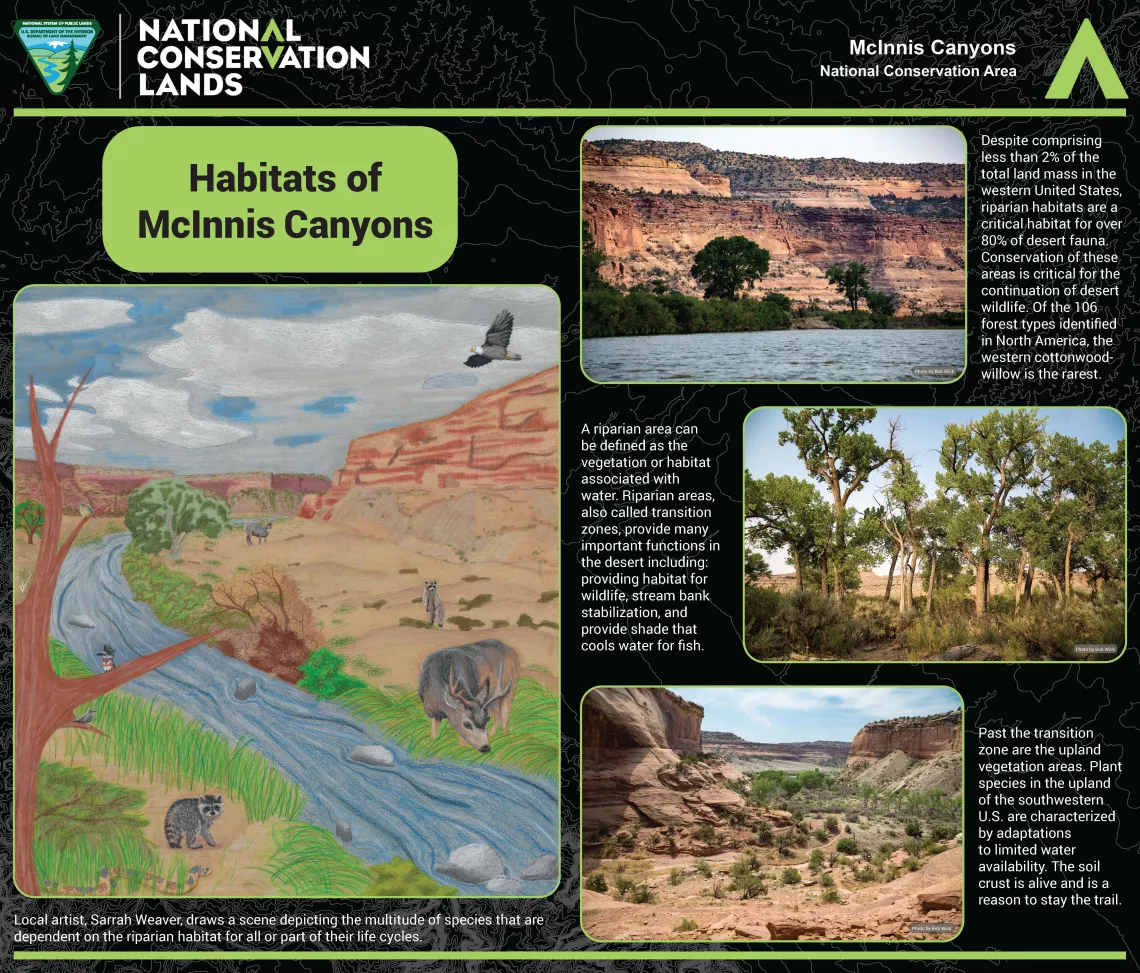
This is the Center Poster:
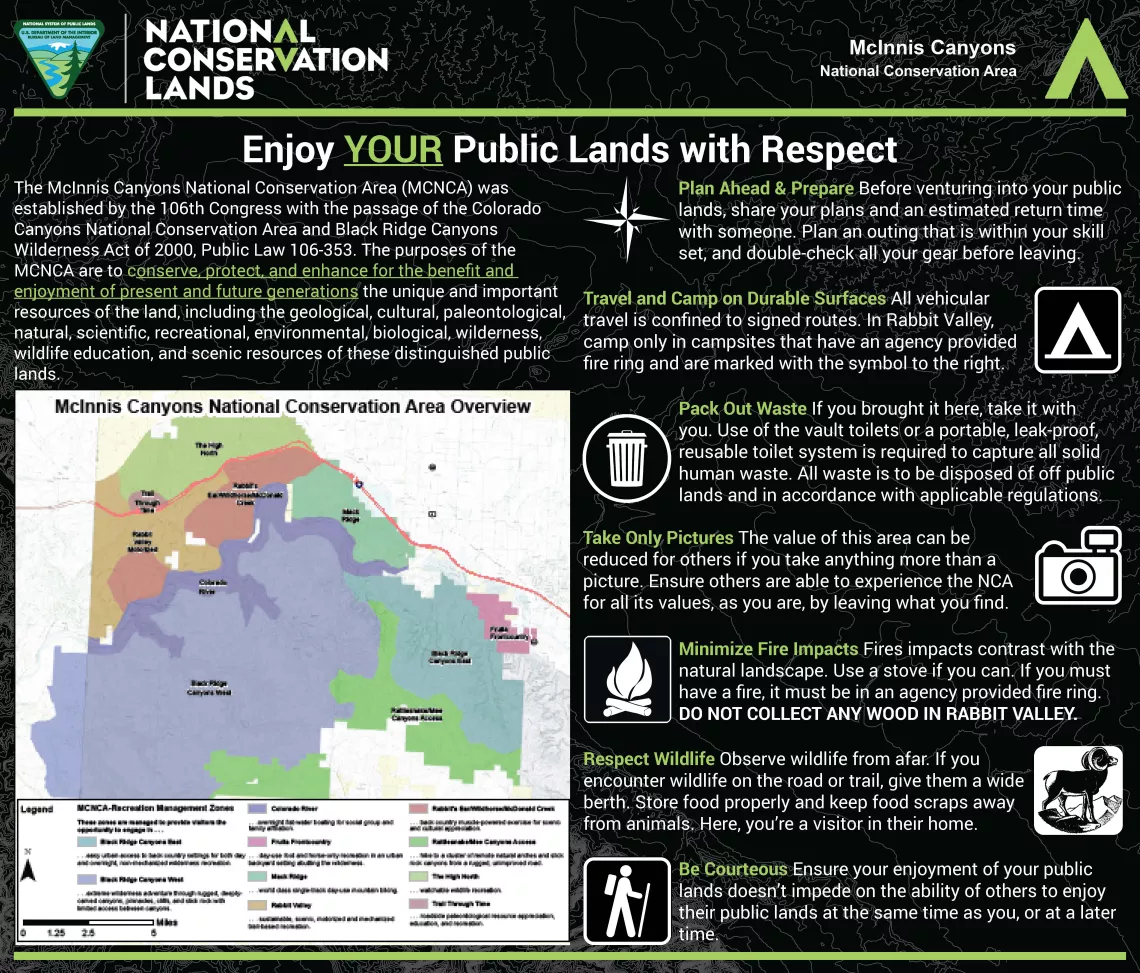
Here is the right poster:
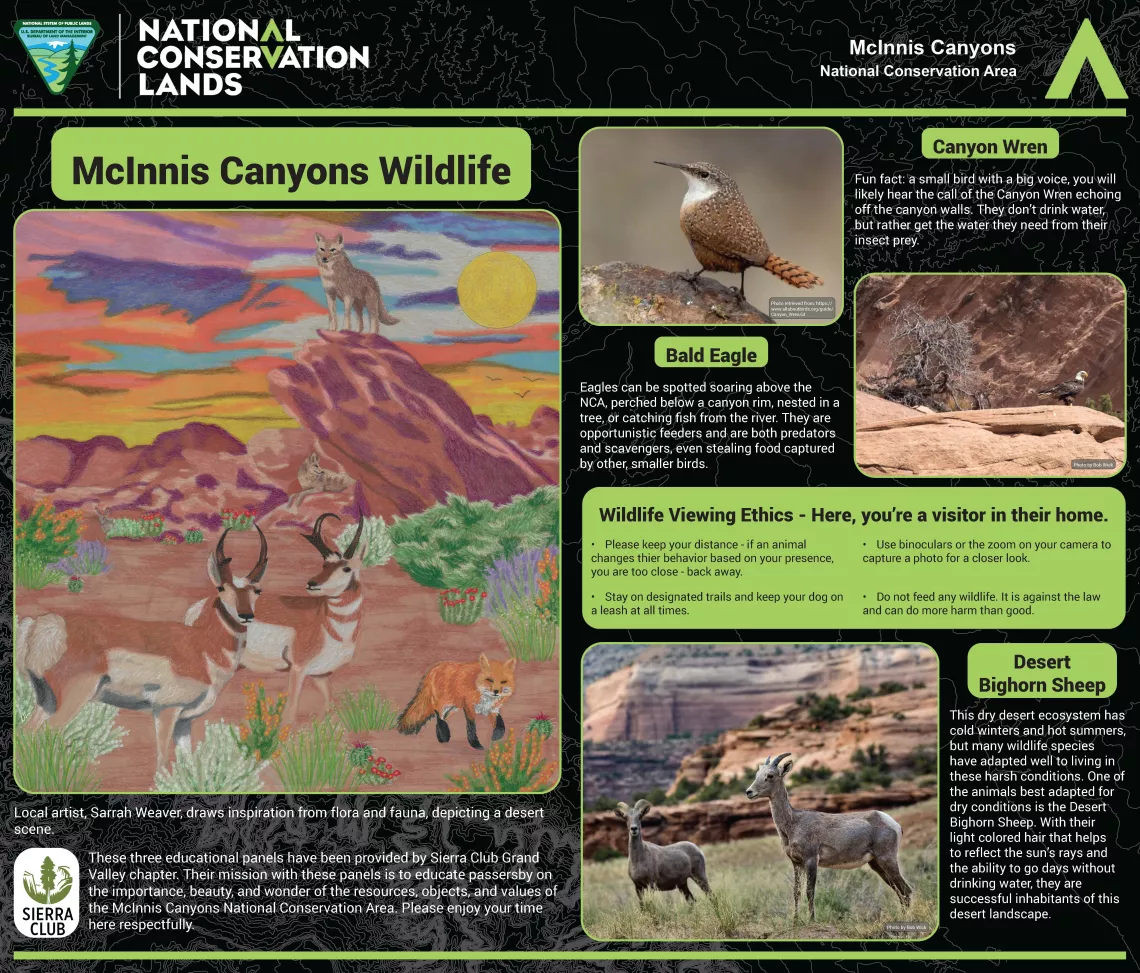
This August 10th, Amber Koski of the local BLM office toured with 5 members of the Western Slope Group , looking at potential sites for the kiosks.
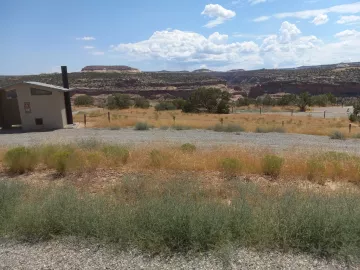
Here is a possible future site for our riparian habitat kiosk at the Knowles Overlook Campground . It looks like the kiosk will be located at the nearby McDonald Creek Trailhead. Below, we are standing in front of a possible prairie dog kiosk site, at the Kokopelli Trailhead off I-70. We decided to locate it instead near the Prairie Canyon Wildlife Emphasis area.
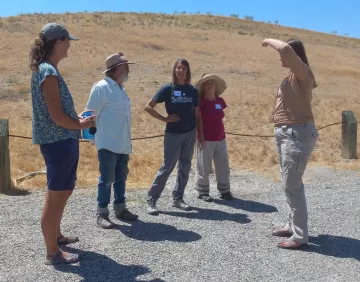
Blog
Half Wild Earth
Please direct comments and questions to Glenn - windandrain51@gmail.com
The 1964 Wilderness Act is America’s greatest contribution to the world, theoretically and practically. This idea has spread all over the world, with thousands and thousands of scientists, artists, philosophers, activists, earth-protectors, and people from all walks of life working to improve and implement it. Today’s challenge is to keep it going, coordinating plans and programs into a global network of wilderness areas that cover half the planet.
Variations of this Wilderness Idea exist, especially in other countries, but the law and spirit (motive and meaning) of this ideal needs to survive in whatever takes place on the ground anywhere and everywhere.
When Bob Marshall, one of the architects of the 1964 Wilderness Act, described wilderness as a place too big to walk across in a single day, and Aldo Leopold, another architect of the Act, described it as a place big enough to absorb a two-week pack trip, they were thinking about the needs of free-roaming apex predators, and about the human need to freely wander and wonder in the wild. They “hunted beauty,” as Leopold put it, because they understood that it is by connecting to the Big Harmony of wilderness that we regain Oneness with wild nature, and they understood that Big Harmony is fragile, easily broken by a road, mine, dam, clear-cut, cattle, etc. They never thought of wilderness as pristine (entirely without human artifacts and activities), but rather they defined it as a large place where the imprint of human beings is “substantially unnoticeable,” where the land retains its “primeval appearance,” and is “untrammeled” by humans, and this conceptual idea of wilderness remains the best for sustaining biodiversity and the wild side of human beings.
There are certainly major problems with the 1964 Wilderness Act, some of which are due to the compromises that were made to pass it into law, and others are due to the historic fact that the science of conservation biology had not yet provided the awareness for continental-scale and global- scale wilderness. Today, we know from the science of conservation biology, pioneered by folks such as Reed Noss, Michael Soule, and E.O. Wilson that real wilderness requires areas of land and water that are large enough, diverse enough, and connected enough to sustain all (or almost all) biodiversity (genes, species, and ecosystems).
In his book ”Half Earth” (2015), two-time Pulitzer-prize winner and world-renown scientist E.O.Wilson concludes: “The only solution to the Sixth Extinction is to increase the area of inviolable natural area to half the surface of the Earth or greater.” Based on his research in Island Bio-geography (beginning in the 1970s) he scientifically demonstrates in his book “Half Earth” that to sustain between 85% to 90% of biodiversity we need an interconnected system of wild reserves that covers half the earth. Right now, only about 15% of land area and 28% of the oceans is protected as wilderness (or “strictly protected” akin to wilderness). According to Wilson, “as more and more species vanish or drop to near extinction, the rate of extinction of the survivors accelerates,” and the loss of biodiversity has reached “tipping points” in many parts of the world at which ecosystems collapse, while at least “two-thirds of the species on Earth remain unknown and unnamed.” Earth remains “a little-known planet,” and we are likely to lose a lot of species before we have even identified them. According to Wilson, anything less than a Half Wild Earth has unknown and risky outcomes because wilderness is the only proven way to sustain biodiversity. We need a Wild Earth, which does not mean that all of the earth needs to be wild, but it does mean that half of the earth needs to be wild to sustain biodiversity, ecological processes, including speciation, and autonomous non-human directed evolution.
This half-wild wilderness ideal does not mean dividing the planet in hemispheric halves, or securing wilderness only in Alaska, Siberia, Antarctica, and other far away places from where many people live, but rather as E. O. Wilson said: “In the mind’s eye it is possible to link a premier terrestrial wildlands system into a single global system, and envision traveling in a near-continuous journey through it all.” This is the kind of planetary-scale wilderness that Life needs: one that spreads its wildways around the whole planet, sustaining all of life on earth in natural patterns and distribution of wildlife similar to what existed prior to modern civilization in the Pleistocene Era, or as close to this baseline as we can get. And for those who haven’t the strength or youth to go far into it they can simply sit and look for 200 miles on a clear day, according to Wallace Stegner, and “take pleasure in the fact that such a timeless and uncontrolled part of the earth is still there.”
This half-wild wilderness ideal does not mean dividing the planet in hemispheric halves, or securing wilderness only in Alaska, Siberia, Antarctica, and other far away places from where many people live, but rather as E. O. Wilson said: “In the mind’s eye it is possible to link a premier terrestrial wildlands system into a single global system, and envision traveling in a near-continuous journey through it all.” This is the kind of planetary-scale wilderness that Life needs: one that spreads its wildways around the whole planet, sustaining all of life on earth in natural patterns and distribution of wildlife similar to what existed prior to modern civilization in the Pleistocene Era, or as close to this baseline as we can get. And for those who haven’t the strength or youth to go far into it they can simply sit and look for 200 miles on a clear day, according to Wallace Stegner, and “take pleasure in the fact that such a timeless and uncontrolled part of the earth is still there.”
Large-scale industrial production for the world market is inseparable from the destruction of wilderness, and the global ruling elite (unipolar or multipolar) will not and cannot accept Half Wild without collapsing the economic system on which their wealth derives. A world-wide movement for Half Wild contradicts the insane aims of the ruling elite, who will never cease destroying the earth unless they are stopped by biophia and environment awareness that take us beyond reforms that are containable within capitalism and its various manifestations in China, Russia, India, and elsewhere. We need to overcome capitalism (as market or plan) before it overcomes us, and there is no way to do this except through a non-violent world-wide wilderness movement for half-wild. Struggles for higher wages, Medicare, free higher education, etc. are not unimportant or insignificant, but they are futile if they are not parts of a world-wide wilderness movement that addresses and changes our self-destructive Way of Life. If we do not stop the spiral of death bound up with limitless materialist lifestyle, then we are all going to die. This is not hyperbole, not scare-tactics, not cynical misanthropy, not unrealistic rhetoric. It is the truth, confirmed by science, and those who do not see the truth, or dare not speak it, are perpetuating a myth of progress that is fatal.
There is no substitute for the goal of a Wild Earth, and no good reason to de-emphasize it in favor of lesser forms of land and water protection. The strategy of protecting as much of the earth as fast as we can, even if it is not wilderness, is too little too late because we only have (probably) a few decades to overcome our insanely expansive lifestyle. Lesser forms of land and water protection are more practical and do-able, and this is precisely their weakness--namely, they can be satisfied by the existing power structure and its global financial institutions. They do not take us beyond this death-dealing culture. There is no grace period in which we can sustain or hold biodiversity and functioning ecosystems in semi-protected reserves, ranches, or mixed landscapes (perhaps for re-wilding later) because we are already in the end-game. There are no stop-gap measures left. What is achieved, at best, by the strategy of securing lesser levels of land and water protection is offset by the further loss of wilderness around the world, which is already accelerating toward the Sixth Extinction. We are facing total ecological collapse in the next few decades, and whatever is achievable within the established world-order is not enough, and that is why it is achievable.
A World Movement for Half Wild sets the standard for land and water protection at a high enough level, qualitatively and quantitatively, that the World Bank, the IMF, and the major multinational corporations cannot possibly meet the standard of Half Wild. They cannot accept a concept of protected land that retains it “primeval appearance,” its beauty, because that requires a completely hands off approach, an aesthetic relationship to land and water. Wilderness is beautiful and it resists all commercial utilization of it. “The surface of the earth is soft,” said Thoreau. The goal of Half Wild is inherently transformational because beauty cannot be compromised! It demands humility and Letting-Be, and that is why the powers-that-be do not like it, and are always seeking less strict forms of land and water protection. We need to insist on real wilderness protection, not compromised forms of land and water protection, because this what sustaining biodiversity requires and what the human spirit requires.
The driving (economic) motive behind smaller and weaker forms of “protection” for land and water is to enable federal agencies such as BLM, the National Forest Service, U.S. Fish and Wildlife Service, on behalf of corporate interests, to permit oil and gas drilling, surface mining, livestock grazing, wind and solar farming, and other commercial-scale renewable energy development on public and private lands. Granted that some particular or specific gains are achieved by lesser forms of land and species protection, the continuing elimination of wilderness around the world is resulting in failure everywhere across the landscape in terms of wildlife decline due to wild habitat loss. The extinction crisis is accelerating. A piecemeal approach to solving it will not work, which is why we need a Half Wild Earth, according the best available science.
Only real wilderness can sustain biodiversity in anything like its pre-modern abundance and distribution, and quite frankly the whole management-mentality of designing elaborate patterns of wildlife and habitat protection is hopeless, rather like trying to put together a jigsaw puzzle with numerous pieces missing and unknown. We do not understand how a single cell works, let alone macro-ecosystems and wild evolution. What hubris and arrogance to think that we can replace wilderness with a giant cybernetic ecology project managed by humans. In fact, our existing designated wilderness areas (the highest level of protection for land in America) have huge internal problems such as grazing, mining, private holdings, etc. that must be removed, and the National Wilderness Preservation System as a whole must be diversified, connected, and expanded to Half Wild World-Wide. Environmental activists who want “to do something” need to understand that unless we are working on a world-wide wilderness preservation system (WWPS), we might as well say good-by to life on earth.
The earth cannot support the load we have placed on it, which is why ecosystems are collapsing everywhere, and will continue to do so along with the rapid extinction of millions of species in the next few decades unless we stop Endless Material Development. Where there is hope, even weak and dwelling hope, there should be a Movement based on it. We need to be more concerned about writing and speaking the truth than about appearing too negative or impractical, and the truth is that at this historical moment we are losing the race between our efforts to preserve biodiversity and wilderness and their obliteration by the powers-that-be. Despite a victory here and there, human caused agents of extinction are, according to Wilson, “synergistic,” which means that “as any agent intensities it causes others to intensify.”
We cannot have psychopaths running the world any longer, using institutions to legitimate their actions. Erica Chenoweth in her book, “Why Civil Resistance Works,” researched hundreds of non-violent revolutionary Movements around the world during the 20th Century, and she discovered that it takes around 3.5% active participation of the population to bring about qualitative social change. According to her research, not many Movements fail after they reach the 3.5% threshold. The 3.5 rule “seems to guarantee success.” A small minority of serious activists, who always represent a much larger number of people who tacitly agree with them, can change the world. When the anthropologist Margaret Mead was asked decades ago if she believed that a handful of people who supported her work at the time could really change the world she replied: “Never doubt that a small group of thoughtful, committed citizens can change the world; indeed, it is the only thing that ever has.”
We happen to be in the unique historical situation in which implementing the most important findings of the science of conservation biology will dismantle the MegaMachine of limitless consumption, so if there was ever a time to speak the scientific truth, and not be concerned with scaring the public or donors, it is certainly now because this scientific truth can save all of life on earth, and it trumps all arguments concerning the difficulties and inconveniences of realizing the goal. As Harvey Locke, co-founder of Earth Needs Half Foundation remarked, “It is time to say it our loud: Earth needs Half-wild.” The best science of conservation biology justifies putting an end to economies of Endless Material Growth (all State-controlled capitalist enterprises that may go by other names). We can live well, very well, without devouring the Wild Earth,” said George Monbiot in his new book, “Regenesis. The goal of a Half Wild Earth “is a moonshot, said E. O. Wilson, but we did put a human on the moon.”
Glenn Parton
High Desert
Out here, there is another way to be.
There is a rising brightness in the rock,
a singing in the silence of the tree.
Something is always moving, running free,
as quick and still as quail move in a flock.
The hills out here know a hard way to be.
I have to listen to it patiently:
a drumming canter slowing to a walk,
a flutter in the silence of a tree.
The owl's call from the rimrock changes key.
What door will open to the flicker's knock?
Out here there is another way to be,
described by the high circle of a hawk
above what sits in silence in the tree.
The cottonwoods in their simplicity
talk softly on, as hidden waters talk,
an almost silent singing in the tree
that says, there is another way to be.
- Ursula K. Le Guin